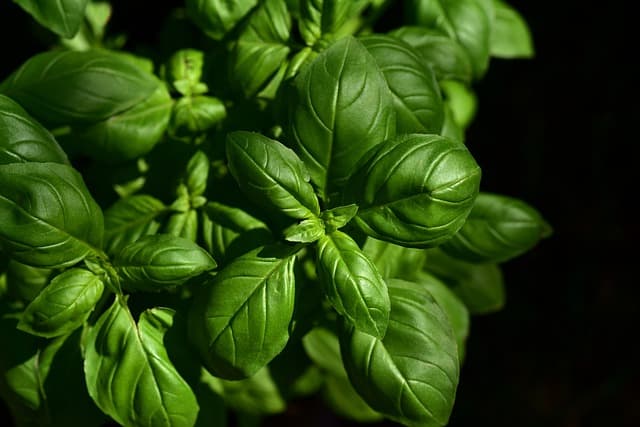Brown spots on basil leaves can be a frustrating problem for gardeners and herb enthusiasts alike. These unsightly spots can indicate a variety of issues, from fungal or bacterial infections to pest infestations and nutrient deficiencies.
Fortunately, there are steps you can take to identify the cause of the problem and treat it effectively, helping your basil plants to thrive and produce healthy, flavorful leaves.
To begin, it’s important to understand how to treat brown spots on basil leaves. These spots may appear as small, dark areas on the leaves, or they may cause the leaves to turn yellow or brown and wilt.
In some cases, the stems of the plant may also show signs of discoloration or decay. By closely examining your basil plants and noting any changes in color or texture, you can begin to narrow down the possible causes of the problem.
Once you have identified the presence of brown spots on your basil leaves, it’s time to explore the common causes of this issue. Bacterial and fungal infections are a common culprit, as are pest infestations and damage.
Nutrient deficiencies, improper watering and spacing techniques, and sunlight and temperature considerations can also contribute to the problem. By understanding these potential causes and remedies, you can take quick action to address the issue and help your basil plants to recover.
Key Takeaways
- Brown spots on basil leaves can indicate a variety of issues, from fungal or bacterial infections to pest infestations and nutrient deficiencies.
- Careful examination of your basil plants can help you narrow down the possible causes of brown spots and take effective action to address the problem.
- By understanding the common causes of brown spots on basil leaves and implementing preventive measures and quick actions, you can help your basil plants to thrive and produce healthy, flavorful leaves.
Also see:
- Brown Spots on Weed Leaves
- Brown Spots Under Monstera Leaves
- Brown Spots Under Fiddle Leaf Fig Leaves
Identifying Brown Spots on Basil Leaves
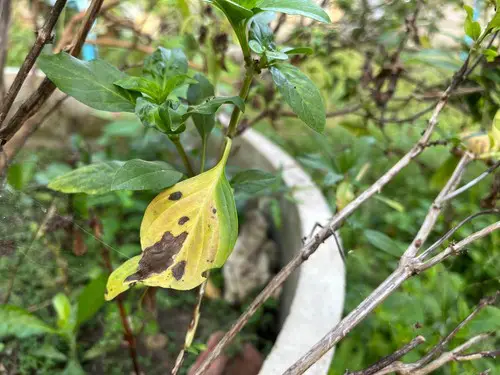
Basil plants are a popular choice for herb gardens due to their aromatic leaves and culinary versatility. However, brown spots on basil leaves can be a sign of disease or other issues that can affect the plant’s growth and flavor. Here are some ways to identify brown spots on basil leaves:
1. Color and Shape
Brown spots on basil leaves can appear in various colors, including yellow, black, and red. The shape of the spots can also vary, from angular to circular. The spots may be small or large, and they can be scattered or concentrated in one area.
2. Leaf Spot Diseases
Brown spots on basil leaves are often caused by fungal or bacterial diseases. Leaf spot diseases, such as Fusarium wilt, downy mildew, and Cercospora leaf spot, can cause brown spots on basil leaves. These diseases can also cause yellowing, wilting, and leaf drop.
3. Pests
Pests, such as aphids and spider mites, can also cause brown spots on basil leaves. These pests feed on the plant’s sap, causing the leaves to turn yellow or brown. In severe cases, the leaves may become distorted or covered in webbing.
4. Nutrient Deficiencies
Brown spots on basil leaves can also be a sign of nutrient deficiencies, such as a lack of nitrogen or calcium. These deficiencies can cause the leaves to turn yellow or brown and can affect the plant’s growth and flavor.
Brown Spots on Basil Leaves – 4 Common Problems
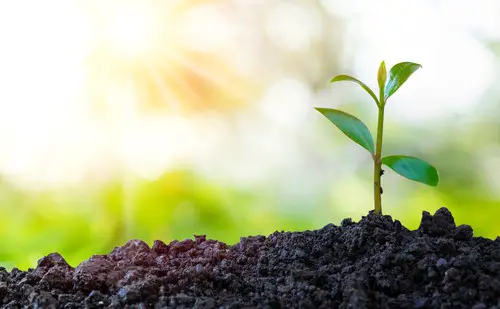
Brown spots on basil leaves can be caused by a variety of factors, ranging from environmental conditions to pests and diseases. Here are some of the most common causes of brown spots on basil leaves:
1. Fungal and Bacterial Infections
Fungal and bacterial infections are among the most common causes of brown spots on basil leaves. These infections can be caused by a variety of factors, including wet or moist conditions, improper watering, and poor air circulation. Some of the most common fungal and bacterial infections that can cause brown spots on basil leaves include:
- Fusarium Wilt
- Fungal Leaf Spot
- Downy Mildew
- Cercospora Leaf Spot
- Bacterial Leaf Spot / Pseudomonas Cichorii
2. Pests
Pests can also cause brown spots on basil leaves by eating holes in the leaves or by transmitting diseases. Some of the most common pests that can cause brown spots on basil leaves include:
- Aphids
- Slugs
- Spider Mites
- Whiteflies
3. Environmental Factors
Environmental factors such as water, sunburn, frost, and cold temperatures can also cause brown spots on basil leaves. Overwatering or underwatering can cause stress to the plant and lead to brown spots.
Sunburn can occur if the plant is exposed to too much direct sunlight, while frost damage can occur if the plant is exposed to freezing temperatures.
4. Nutrient Deficiencies
Brown spots on basil leaves can also be caused by nutrient deficiencies, such as a lack of nitrogen or potassium in the soil. This can be addressed by fertilizing the plant with a balanced fertilizer.
Bacterial and Fungal Infections
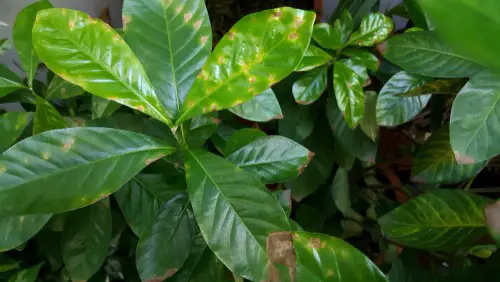
Brown spots on basil leaves are often a result of bacterial or fungal infections. Bacterial leaf spot, caused by the Pseudomonas cichorii bacteria, is a common culprit.
The bacteria often arrive from contaminated transplants or seeds, and the infected leaves appear to have water-soaked brown and black areas on the leaves and stems. The leaf spots will appear irregular or angular and separated by small veins.
Fungal infections, such as downy mildew, mildew, fusarium wilt, cercospora leaf spot, and fungal leaf spot, can also cause brown spots on basil leaves. Downy mildew is a common fungal disease that affects basil plants.
It starts as yellow spots on the upper side of the leaves and progresses to brown spots on the underside. Mildew is another fungal disease that can cause brown spots on basil leaves.
It is characterized by white or grayish powdery spots on the leaves and stems. Fusarium wilt is a fungal disease that causes yellowing and wilting of the leaves, followed by brown spots on the stems.
Cercospora leaf spot is a fungal disease that causes brown spots on the leaves and stems. Fungal leaf spot, caused by Colletotrichum, is a fungal disease that causes brown spots on the leaves and stems.
Botrytis, also known as gray mold, is a fungal disease that can cause brown spots on basil leaves. It is characterized by grayish-brown spots on the leaves and stems. Bacterial diseases, such as bacterial leaf spot / Pseudomonas cichorii, can also cause brown spots on basil leaves.
Treating bacterial and fungal infections requires different approaches. Fungal diseases can be treated with fungicides, such as copper-based fungicides, sulfur-based fungicides, or neem oil.
However, prevention is the best approach to avoid fungal diseases. Proper watering, good air circulation, and avoiding overhead watering can help prevent fungal diseases.
Bacterial diseases are more difficult to treat than fungal diseases. There are no good treatments for bacterial leaf spot / Pseudomonas cichorii, but you can help avoid it by maintaining good hygiene practices, such as using clean tools, avoiding overhead watering, and buying disease-free seeds.
Pest Infestations and Damage
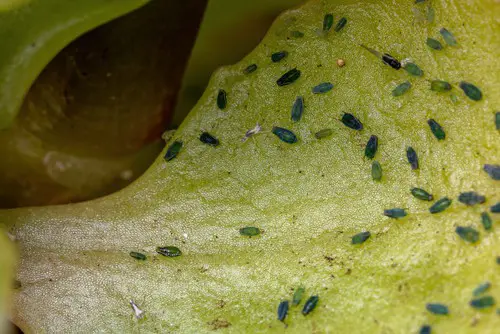
Basil plants are susceptible to pest infestations, which can cause brown spots on basil leaves. Some common pests that can damage basil plants include aphids, slugs, and thrips.
Aphids are tiny insects that feed on the sap of the basil plant. They can cause yellowing of the leaves and stunted growth. To control aphids, gardeners can spray the plants with a strong jet of water or use reflective mulches to deter them.
Insecticides such as neem oil and insecticidal soaps can also be effective against serious infestations.
Slugs are another common pest that can damage basil plants. They feed on the leaves and can cause holes and brown spots. To control slugs, gardeners can use slug baits or traps, or they can handpick the slugs and dispose of them.
Thrips are tiny insects that feed on the leaves and flowers of the basil plant. They can cause brown spots and distortions on the leaves. To control thrips, gardeners can use insecticidal soaps or neem oil.
In addition to pests, other factors can cause damage to basil plants. Overwatering, underwatering, and nutrient deficiencies can all lead to brown spots on the leaves. Gardeners should ensure that the basil plants are getting adequate water and nutrients, and they should avoid overfertilizing.
Nutrient Deficiencies and Remedies
Basil plants can develop brown spots due to a lack of essential nutrients. Nutrient deficiencies can occur when the soil lacks the necessary minerals or when the plant is unable to absorb them. In such cases, the leaves may turn yellow, wilt, or develop brown spots.
One common nutrient deficiency that can cause brown spots on basil leaves is a lack of nitrogen. Nitrogen is essential for the growth of the plant and the development of chlorophyll.
Without enough nitrogen, the leaves may turn yellow and develop brown spots. To remedy this, gardeners can apply a nitrogen-rich fertilizer to the soil. A balanced fertilizer with equal amounts of nitrogen, phosphorus, and potassium can also help prevent nutrient deficiencies.
Another nutrient deficiency that can cause brown spots on basil leaves is a lack of calcium. Calcium is essential for the development of strong cell walls in plants. Without enough calcium, the leaves may develop brown spots, and the plant may become stunted.
To remedy this, gardeners can apply a calcium-rich fertilizer to the soil. They can also add crushed eggshells or bone meal to the soil to increase the calcium content.
Magnesium deficiency can also cause brown spots on basil leaves. Magnesium is essential for the development of chlorophyll, and without enough magnesium, the leaves may turn yellow and develop brown spots.
To remedy this, gardeners can apply Epsom salt to the soil. Epsom salt is rich in magnesium and can help prevent nutrient deficiencies.
In addition to fertilizers, gardeners can also use compost to improve the nutrient content of the soil. Compost is rich in organic matter and can help improve the soil structure and fertility.
Gardeners can also rotate their crops to prevent nutrient deficiencies. Planting different crops in the same soil year after year can deplete the soil of essential nutrients, leading to nutrient deficiencies.
Proper Watering and Spacing Techniques

Proper watering and spacing techniques are essential to prevent brown spots on basil leaves. Overwatering and poor air circulation can cause fungal and bacterial diseases that result in brown spots on leaves. Here are some tips to help maintain good watering habits and adequate plant spacing:
- Watering: Basil requires consistent moisture, but overwatering can cause root rot and other diseases. Water the plants deeply once a week and allow the soil to dry out slightly before watering again. Use a soaker hose or drip irrigation to avoid splashing water onto the leaves, which can lead to fungal diseases.
- Spacing: Adequate plant spacing is crucial to promote good air circulation and prevent the spread of diseases. Basil plants should be spaced at least 12 inches apart to allow for proper growth and air circulation. Crowded plants can create a humid environment that promotes the growth of fungal diseases.
- Good Watering Habits: In addition to proper watering frequency, it is important to water the plants at the right time of day. Watering in the morning allows the leaves to dry out during the day, reducing the risk of fungal diseases. Avoid watering in the evening, as the leaves will remain wet overnight, increasing the risk of fungal diseases.
Using these proper watering and spacing techniques can help prevent brown spots on basil leaves and promote healthy growth.
Sunlight and Temperature Considerations
Basil plants thrive in warm weather and require plenty of sunlight to grow and produce healthy leaves. Ideally, basil plants should be exposed to at least six hours of direct sunlight each day. However, excessive heat and sunlight can also cause damage to the leaves, leading to brown spots.
If the basil plant is exposed to too much sunlight, the leaves may wilt and turn brown. In such cases, it is recommended to provide some shade to the plant. Shade cloth can be used to reduce the amount of direct sunlight the plant receives. Shade cloth can be easily purchased online or at a local gardening store.
On the other hand, cold damage can also cause brown spots on basil leaves. Basil plants are susceptible to cold temperatures and should not be exposed to temperatures below 50°F (10°C).
If the plant is exposed to cold temperatures, the leaves may turn brown and wilt. In such cases, it is recommended to move the plant to a warmer location or cover it with a frost cloth.
If you are growing basil indoors, it is important to ensure that the plant receives enough sunlight. Place the plant near a sunny window or use grow lights to provide adequate light.
It is also important to maintain a consistent temperature in the room where the plant is located. Avoid placing the plant near drafts or air conditioning vents, which can cause fluctuations in temperature.
Preventive Measures and Quick Actions

Preventing brown spots on basil leaves is better than trying to treat them. Here are some preventive measures that can be taken to avoid brown spots on basil leaves:
- Safe Seeds: Always use high-quality seeds from a reputable source to avoid introducing diseases into your garden.
- Proper Watering Habits: Basil plants require consistent moisture, but overwatering can lead to root rot and other diseases. Allow the top inch of soil to dry out between watering sessions.
- Adequate Plant Spacing: Proper spacing between plants allows for good air circulation, which can help prevent fungal diseases.
- Mulch: Mulching around the base of the plants can help retain moisture and prevent soil-borne diseases.
- Pruning: Regularly pruning basil plants can help promote healthy growth and prevent overcrowding, which can lead to disease.
If brown spots do appear on basil leaves, quick action is necessary to prevent further damage. Here are some quick actions that can be taken to treat brown spots on basil leaves:
- Neem Oil: Neem oil is a natural and organic fungicide that can be used to treat fungal diseases, including those that cause brown spots on basil leaves. Mix neem oil with water and spray the affected plants thoroughly.
- Fungicides: Fungicides can be used to treat fungal diseases, but care should be taken to choose a product that is safe for use on edible plants.
- Pruning: Removing affected leaves and branches can help prevent the spread of disease to healthy parts of the plant.
By following these preventive measures and taking quick action when brown spots appear on basil leaves, gardeners can enjoy a healthy and abundant harvest of this delicious herb.
Final Thoughts
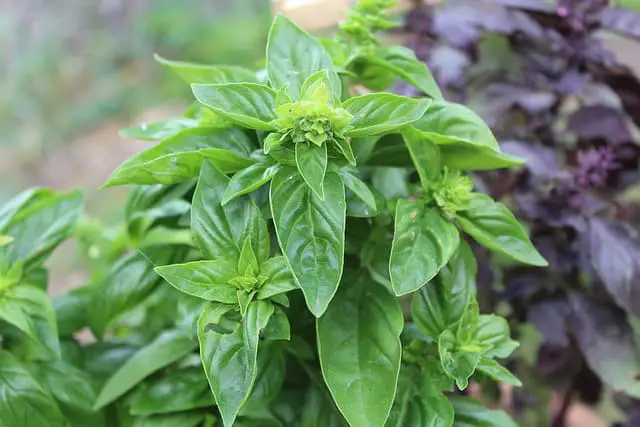
One of the most effective ways to prevent brown spots on basil leaves is to maintain proper moisture levels and improve air circulation. Basil should be watered regularly, but not overwatered, as this can lead to root rot.
Additionally, proper spacing and pruning of the plant can help improve air circulation and reduce the risk of fungal diseases.
It is also important to choose the right variety of basil for the growing season and climate. Sweet basil varieties are the most commonly grown and are best suited for warm weather. In India, basil is commonly grown during the monsoon season.
If brown spots or other signs of disease appear on basil leaves, it is important to act quickly to prevent the spread of the disease. Infected leaves should be removed and disposed of properly. If the disease persists, it may be necessary to use fungicides or other treatments.
Finally, it is important to note that basil leaves with brown spots are generally safe to eat, but it is always best to err on the side of caution. If the spots are accompanied by other signs of disease, such as black spots or basil shoot blight, the leaves should be discarded.
Frequently Asked Questions
How do you treat brown spots on basil leaves?
Brown spots on basil leaves can be caused by various factors such as fungal or bacterial infections, pests, nutrient deficiencies, or overwatering.
To treat brown spots on basil leaves, it is important to first identify the underlying cause. For fungal or bacterial infections, remove the affected leaves and treat the plant with a fungicide or bactericide.
For pests, use an insecticidal soap or neem oil. For nutrient deficiencies, fertilize the plant with a balanced fertilizer. And for overwatering, adjust the watering schedule and ensure proper drainage.
What does overwatered basil look like?
Overwatered basil may have yellow or brown leaves that are droopy or wilted. The leaves may also have a soft, mushy texture and may fall off easily. In severe cases, the roots may rot and the plant may die.
How do you treat fungus on basil leaves?
To treat fungus on basil leaves, remove the affected leaves and treat the plant with a fungicide. It is also important to improve air circulation around the plant and avoid overhead watering.
Is it safe to eat basil with black spots?
Basil with black spots may be an indication of a fungal or bacterial infection. While some sources suggest that it is safe to eat the leaves after removing the affected parts, it is generally recommended to avoid consuming basil with black spots to prevent the spread of infection.
Are brown spots on basil leaves safe to eat?
Brown spots on basil leaves may be caused by various factors such as nutrient deficiencies or overwatering. While the leaves may still be safe to eat, it is generally recommended to remove the affected parts to improve the quality and flavor of the basil.
Can I use brown basil leaves in pesto?
While brown basil leaves may still be safe to eat, they may have a bitter taste and may affect the flavor of the pesto. It is generally recommended to use fresh, healthy basil leaves for the best flavor and quality of the pesto.

Hey, I’m Lisa and I’ve been an avid gardener for over 30 years. I love writing, talking and living in the garden! Feel free to connect with me on my socials below

